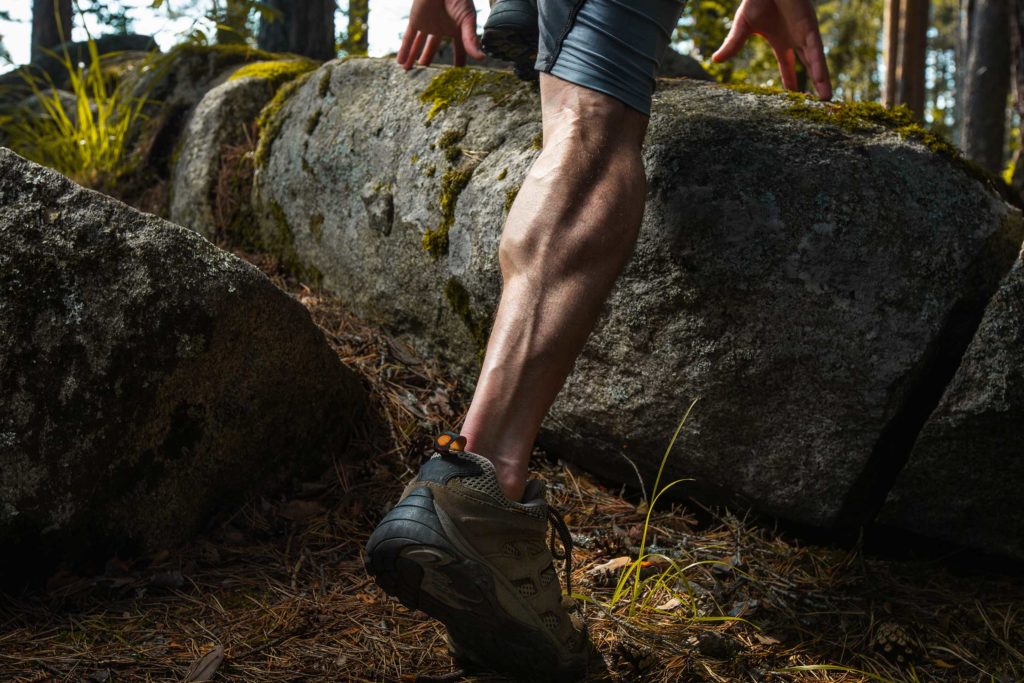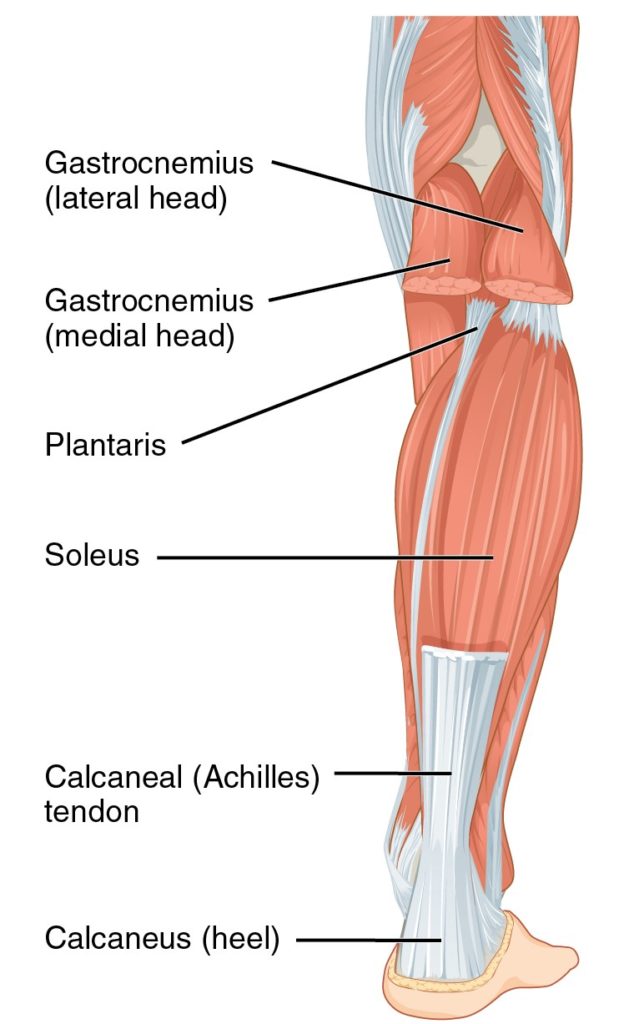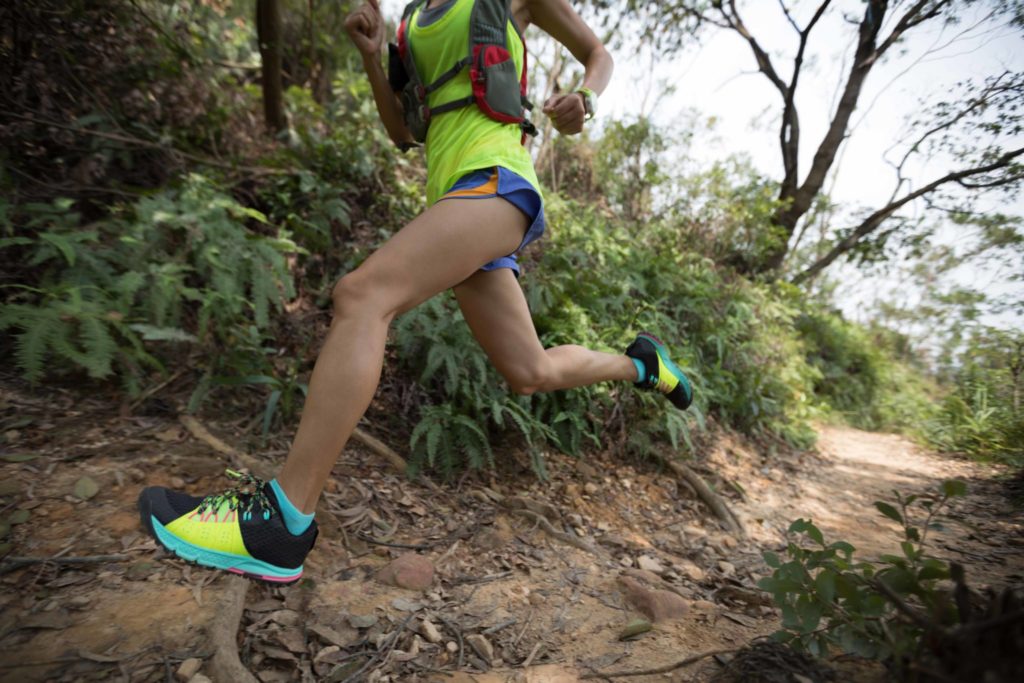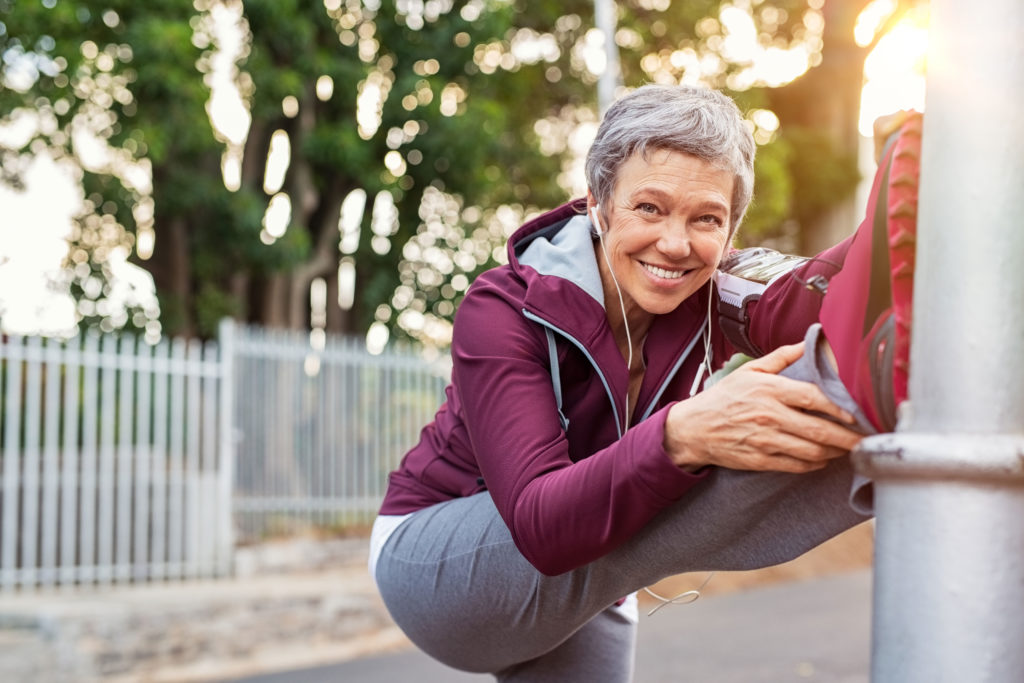Strong Calves for Safe Running

Take Home Message
– Calf muscle strains are common and can lead to a significant amount of time spent injured
– The major risk factors for calf injury are age, previous calf injury, and for amateur athletes, a lack of conditioning
– For highly trained athletes the risk factors for calf muscle strain are sprinting, rapid acceleration and direction change, large running loads, and running while in a fatigued state
– A calf training program that includes jump rope, high-rep calf raises and heavy calf raises can prevent running-related calf injuries
Calf Injuries are Common
Calf injuries are common in sports involving high-speed running, high running volumes, running that involves a large amount of acceleration and deceleration, and running when fatigued 1. This is why calf injuries are so common in professional sports 2,3,4,5. Calf muscle injuries are also prevalent in recreational runners of all ages and athletic abilities 6.
As usual, age is a major risk factor for calf injury. Within recreational athletes, poorly conditioned men between 40 to 60 years old are the highest risk group for calf injury 1. Amongst highly trained athletes, Masters athletes have a disproportionately high risk of calf injury compared to younger athletes 1. Sadly, the older you are, the more calf training you need to do.
Simple Calf Anatomy and Function
The soleus and gastrocnemius calf muscles are by far the most frequently injured during running 2.
The gastrocnemius muscle begins at the Achilles tendon and branches into two heads that insert at either side of the femur. This is the muscle that is closest to the skin and endows the calf with the classic diamond shape so coveted by bodybuilders and figure athletes (Figure 1). Lying under the gastrocnemius is the closely related soleus muscle, which along with the gastrocnemius is joined to the Achilles tendon and runs beneath the gastrocnemius muscle to insert below the knee (Figure 1).

Recent musculoskeletal studies show that during running the primary functions of the calf muscles are to provide upward and forward acceleration to the body. Both these functions are required to support and propel the body forward when running at steady‐state speeds 9,10. Calves are essential for maximum acceleration during sprinting 11.
Of all the major lower‐limb muscle groups, the combined soleus and gastrocnemius muscles generate the largest forces when the forward leg strikes the ground and begins pushing backwards 10,12. This is also the precise moment of many calf injuries, as discovered when analysing the video footage of a gastrocnemius muscle strain that occurred during rapid acceleration 13.
Why Calf Injuries Suck
When running at high speeds the soleus and gastrocnemius collectively generate a peak force that can exceed 12.5 times your body weight 9. Because the Achilles muscle-tendon insertion is repeatedly subjected to the largest loads during running, this is where most calf injuries occur 6.
The damage to the muscle-tendon structure can be quite severe due to the large impact forces involved, and may require surgery and extensive rehabilitation 5. For these reasons it is essential that calf muscle injuries are correctly diagnosed and treated by a qualified physician. Or better yet, avoided altogether.
Because the soleus muscle is comprised primarily of slow‐twitch muscle fibres, a higher proportion of soleus injuries occur while hiking, jogging and running fast 2 . Soleus injuries often present as a slowly cumulative condition that takes time to reach the fully injured state, and usually take longer to recover than gastrocnemius injuries 2.
The gastrocnemius is composed mainly fast-twitch fibres, which explains why most gastrocnemius injuries occur during high intensity running 2. Gastrocnemius injuries often present as a single discrete event during a high-speed activity such as sprinting or jumping 2.
Unfortunately, calf injuries take a long time to heal. In young professional athletes, calf muscle injuries take on average one month for full recovery 2. Training or competing with an incompletely healed muscle makes you more vulnerable to re-injury. Calf re-injury is more likely to occur in older athletes, presumably because older athletes take a longer time to heal 2.
Calf muscle re‐injuries occur almost exclusively in the soleus muscle. This is for two reasons. First, the soleus operates at near maximal capacity across a large range of running speeds 12,15,18. This makes it vulnerable to re-injury in all forms of running, from jogging to sprinting.
Second, The soleus muscle has a much larger physiological cross‐sectional area than gastrocnemius 14 . Therefore the soleus experiences larger force‐generating demands during running, jumping, and changes of direction 12,15,16,17. Again, this increases the probability of re-injuring the soleus muscle.
Exercises to Strengthen the Calves for Running
In contrast to the extensive literature regarding hamstring injury prevention, I could not find any clinical trials or research papers that address calf injury prevention. By necessity, the remainder of this article is based on my personal calf rehabilitation experience.
My calf injury was a gradual-onset soleus strain that occurred in both calves during hill sprinting. The training approach I outline below worked well for me. I can now sprint and jump without pain. Most importantly, I have not been re-injured.
1. Jump Rope
This ancient form of exercise is a go-to exercise for conditioning the calves for running. It is simple, safe, effective, and easy to program.
Jump rope can be used to train both fast and slow twitch muscle fibres while placing the calf muscles and feet under similar stress found in running, i.e. repeatedly transferring force from the body to the ground. Jump rope is also an excellent method to develop aerobic and anaerobic work capacity and improve timing and co-ordination. Skipping also conditions the connective tissue of the calves and feet to transfer energy from the body to the ground at high speed. For these reasons I highly recommend skipping as a conditioning method.
My personal training approach with jump rope is extremely straight-forward. I began by doing one-minute rounds, keeping the pace fast, with a 45 second rest interval. I slowly worked up to 20 one-minute rounds, then I gradually reduced the rest interval between rounds until I was doing one uninterrupted 20-minute interval. Now, I stay at 20 minutes duration and focus on increasing and maintaining a high work-rate for the entire session. And that’s it.
This is a simple and safe progression that can be used to build or rebuild your calves in preparation for more challenging exercises. This approach works well for me, but to be honest this workout is incredibly boring.
If you take the time to learn a few basic skipping moves, you can dramatically improve the training effects jump rope training. For instance, you can easily learn to run quickly in place while skipping, and with a bit of work you can also learn how to perform double-unders (two passes of the rope in a single jump).
Either one of these skipping variations can transform a boring workout into a highly effective sprint-interval training session. You could try performing 40 second active rest intervals at a moderate skipping pace, interspersed with 20 seconds of fast-running or double-unders. Ten to twenty rounds of this interval program works both the slow and fast-twitch muscle fibres of the calf.
Here are links to two outstanding coaches. The first is Jason Van Veldhusen of precisionstriking.com, who provides an excellent jump rope instructional video as well as a vast amount of high quality of training methods for boxing and general fitness.
The second is Ross Enamait at ROSSTRAINING.COM. Ross is a strength and conditioning genius who also has some outstanding jump rope workouts as well as many excellent strength and conditioning articles.
I suggest that you first focusing on perfecting a simple skipping style. Once you have mastered the basics, feel free to move onto more advanced programs when your calves are ready for the extra work. A conservative, progressive approach is especially important if you are recovering from a calf injury and/or you are an older athlete, as both factors are significant predictors of future injury.
2. High rep calf raises for strength-endurance

A contributing factor to calf strain injuries is low calf strength-endurance. As the training load increases, fatigue accumulates in the soleus muscle, leading to an increased probability of functional failure under load.
To address this weakness, I perform high repetition standing calf raises under load. I began with 25 repetitions using my body weight, and as my calves became conditioned, I gradually increased the rep range up to 100 total repetitions.
Be aware that the first time you try high repetition calf training, the delayed onset muscle soreness can be severe. It’s highly recommended that you start with a low number of repetitions and progress gradually as your calves adapt. Calf muscles rapidly adapt to high workloads, so it shouldn’t take long for you to be able to complete 100 bodyweight reps without being sore the next day.
Once you can easily achieve 100 reps without muscle soreness, it’s time to add weight. A weight vest is the easiest option for this. If you don’t have a weight vest use a standing calf raise machine, a Smith machine or switch to single legged calf raises.
The point is to continue high-rep calf raises while progressively increasing the load to continue increasing the strength-endurance capabilities of your calves.
This is my number one calf injury prevention method. Do this twice a week, forever.
3. Heavy Calf Raises
The gastrocnemius muscles are primarily fast-twitch fibres, which respond best to heavy loading. That means lifting heavy weights in the 4-8 rep range using good form.
Building strong calves will improve your explosive power and increase your acceleration and sprint speed 19. Strong muscles don’t have to work as hard as weak muscles. Thus, building stronger calves will also improve your strength-endurance and make you more robust to calf injury.
I recommend standing calf raises, for the simple reason that people sprint while standing. If you prefer seated calf raises, that’s fine. Just be sure to warm up on light weights and gradually progress up to the maximum weight of the day. Use a full range of motion and be in control of the weight for the entire set. Do 3-4 sets of 4-8 repetitions at you working weight.
As usual, I recommend starting light with higher reps and utilise a progressive overload approach over time to gradually increase the weight, just as you would for any other muscle group. This is mandatory when recovering from injury.
4. Mobility
Mobility is essential in all things, including sprinting and running. Remember to include some calf stretching and mobility work in your program. If you have issues with calf mobility, make calf stretching and mobility drills a priority in your programming.
Whatever you do, don’t over-stretch! Muscle tears caused by over-stretching are bad. Be gentle, consistent and patient with your mobility work.
A Holistic Calf Program for Sprinting and Running
Calves are tough and can be trained almost every day. That said, they are not indestructible. Hence, I recommend picking just one training method per day. A simple example is Day 1; Skipping, Day 2; heavy standing calf raises, Day 3; high rep standing calf raises.
Schedule calf training for the end of your work out. Start light and gradually increase weight and intensity over time so that you continue to improve while staying below the intensity threshold that causes extreme fatigue and delayed onset muscle soreness. Perform your stretching after your heavy exercising as part of your cool-down protocol.
You should program your calf training so that you aren’t running with fatigued calves. For example, I consider sprinting workouts to be a form of calf training. Therefore I don’t perform any specific calf training on the days that I sprint. I just sprint.
If you’ve experienced an injury, don’t rush back to running until you feel strong and ready. As usual, recommence your running at a much lighter load than you think you should and gradually increase running volume and intensity as appropriate. Any rehabilitation performed after serious injury should be performed under medical supervision.
At some point you are going to need to get back to running. Depending on your age and injury status, this can take anywhere from 1-6 months. For me, even though my injuries were not severe, my recovery took six months. This was because my calves were under-trained and constituted a significant weak point.
Conclusion
Calves are regularly injured during sport and are responsible for a significant injury burden in both recreational and professional athletes. Calf injuries can also be very severe. Given these facts, there are surprisingly few published articles that specifically address how to best to train calves in order to prevent injury.
By neccessity, this article is subjective and based on my own personal experience of rehabilitating and preventing my own calf injuries. To alleviate the subjective nature of this article, I’ve kept my recommendations in line with what is known about calf structure, calf function and the common calf injuries that occur during running.
I hope you find this information useful.
References and Further Reading
1 Fields, K. B. & Rigby, M. D. Muscular Calf Injuries in Runners. Curr Sports Med Rep 15, 320-324 (2016).
2 Green, B. et al. Calf muscle strain injuries in elite Australian Football players: A descriptive epidemiological evaluation. Scand J Med Sci Sports 30, 174-184 (2020).
3 Werner, B. C. et al. Acute Gastrocnemius-Soleus Complex Injuries in National Football League Athletes. Orthopaedic Journal of Sports Medicine 5 (2017).
4 Korkia, P. K., Tunstall-Pedoe, D. S. & Maffulli, N. An epidemiological investigation of training and injury patterns in British triathletes. Br J Sports Med 28, 191-196 (1994).
5 Campbell, J. T. Posterior calf injury. Foot Ankle Clin 14, 761-771 (2009).
6 Green, B. & Pizzari, T. Calf muscle strain injuries in sport: a systematic review of risk factors for injury. Br J Sports Med 51, 1189-1194 (2017).
7 Edgerton, V. R., Smith, J. L. & Simpson, D. R. Muscle fibre type populations of human leg muscles. Histochem J 7, 259-266 (1975).
8 Gollnick, P. D., Sjödin, B., Karlsson, J., Jansson, E. & Saltin, B. Human soleus muscle: a comparison of fiber composition and enzyme activities with other leg muscles. Pflugers Arch 348, 247-255 (1974).
9 Komi, P. V. Relevance of in vivo force measurements to human biomechanics. J Biomech 23 Suppl 1, 23-34 (1990).
10 Hamner, S. R. & Delp, S. L. Muscle contributions to fore-aft and vertical body mass center accelerations over a range of running speeds. J Biomech 46, 780-787 (2013).
11 Debaere, S., Delecluse, C., Aerenhouts, D., Hagman, F. & Jonkers, I. Control of propulsion and body lift during the first two stances of sprint running: a simulation study. J Sports Sci 33, 2016-2024 (2015).
12 Dorn, T. W., Schache, A. G. & Pandy, M. G. Muscular strategy shift in human running: dependence of running speed on hip and ankle muscle performance. J Exp Biol 215, 1944-1956 (2012).
13 Orchard, J. W. et al. Exact moment of a gastrocnemius muscle strain captured on video. Br J Sports Med 36, 222-223 (2002).
14 Fukunaga, T. et al. Physiological cross-sectional area of human leg muscles based on magnetic resonance imaging. J Orthop Res 10, 928-934 (1992).
15 Lai, A., Schache, A. G., Lin, Y.-C. & Pandy, M. G. Tendon elastic strain energy in the human ankle plantar-flexors and its role with increased running speed. J Exp Biol 217, 3159-3168 (2014).
16 Hof, A. L., Van Zandwijk, J. P. & Bobbert, M. F. Mechanics of human triceps surae muscle in walking, running and jumping. Acta Physiol Scand 174, 17-30 (2002).
17 Maniar, N., Schache, A. G., Cole, M. H. & Opar, D. A. Lower-limb muscle function during sidestep cutting. J Biomech 82, 186-192 (2019).
18 Schache, A. G., Dorn, T. W., Williams, G. P., Brown, N. A. T. & Pandy, M. G. Lower-limb muscular strategies for increasing running speed. J Orthop Sports Phys Ther 44, 813-824 (2014).
19 Möck, S., Hartmann, R., Wirth, K., Rosenkranz, G. & Mickel, C. Correlation of dynamic strength in the standing calf raise with sprinting performance in consecutive sections up to 30 meters. Research in Sports Medicine 26, 474-481 (2018).

Ten Minutes is All You Need
Research has shown that ten minutes of moderate-to-vigorous exercise performed each day is enough to significantly reduce your risk of early death.

How to Find Significance in Life: Thriving in Solitude Part Three
Meaning in life research provides several behaviors and beliefs that can help you find significance in life.




